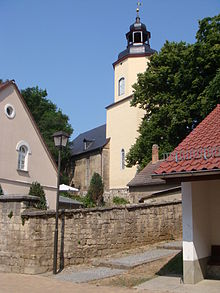St. Vitus (Wickerstedt)
The Protestant village church of St. Vitus is a baroque hall church in the Wickerstedt district of Bad Sulza in the Weimarer Land district in Thuringia . It belongs to the parish of Bad Sulza II in the Apolda-Buttstädt parish of the Evangelical Church in Central Germany .
History and architecture
The single-nave church with a retracted, almost square choir tower was built in 1680 possibly reusing parts of the previous building. After a fire in 1719, restoration and refurbishment began, which probably lasted until 1739, the date on the weather vane . In the years 1873–1875 the building was renovated and a sacristy in the form of an east apse was added. A comprehensive restoration was carried out from 1986 to 1993.
Large, chamfered and partly renewed pointed arch windows from 1680 are built into the nave and choir. Other window shapes and door openings as well as the octagonal tower top with a curly dome were created in the 18th century. The interior design with a three-sided, two-storey gallery and vaults with stucco decoration is similar to the church in Eberstedt and was probably created at the same time. A barrel vault with stucco frames and incised stucco-framed windows and six vaulted medallions with the birth and passion of Christ and the Evangelists as well as painted stucco mirrors with scenes from the Old Testament is stretched over the central space of the ship. On the shield walls , which are set off by a surrounding cornice as in Eberstedt, there are thematically corresponding painting cartouches in rich stucco framing; all of these paintings are of a rather handcraft quality.
Furnishing
A three-axis, two-zone pulpit altar from 1875 is structured with slender columns and pilasters . A painting of the Last Supper from an earlier pulpit altar from the 18th century is now attached to the patron's box in the west of the ship. A small crucifix from the early 16th century is placed above the altar. The furnishings are complemented by a goblet-like baroque baptismal font, which could also be a new creation from the late 19th century. The organ is a work by Heinrich Nicolaus Trebs from 1738 with 20 stops on two manuals and pedal . It was rebuilt in 1863/64 by Adalbert Förtsch , Blankenhain, and expanded in 1917/20 by Friedrich Wilhelm Heerwagen , Weimar. The sound was redesigned in 1973/74 by Speerschneider, Weimar. Between 2004 and 2007 the instrument was restored by Orgelbau Waltershausen .
literature
- Handbook of German Art Monuments. Thuringia. 1st edition. Deutscher Kunstverlag Munich / Berlin 1998, ISBN 3-422-03050-6 , p. 1380.
Web links
Individual evidence
- ↑ Information about the organ on orgbase.nl. Retrieved April 8, 2020 .
Coordinates: 51 ° 3 '29.4 " N , 11 ° 32' 17.2" E

